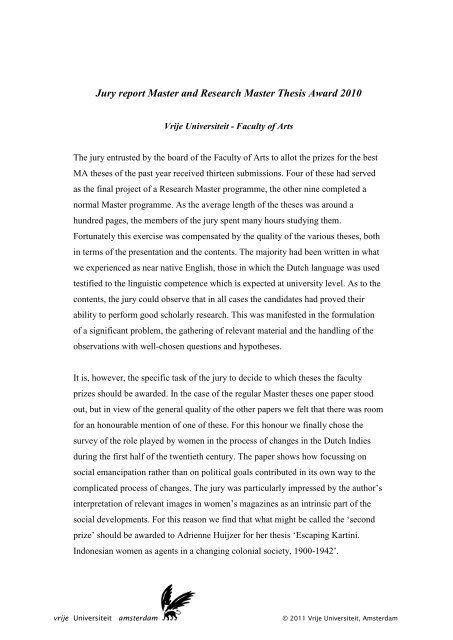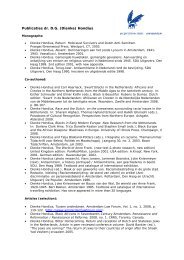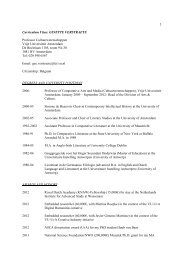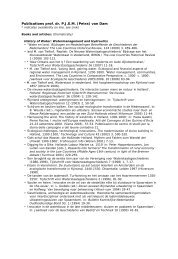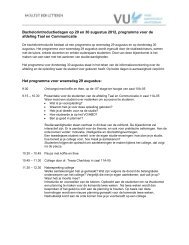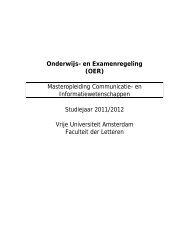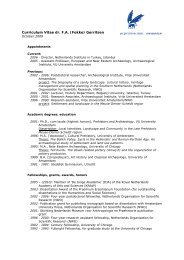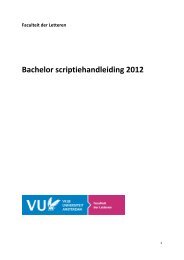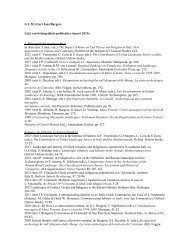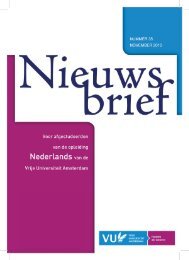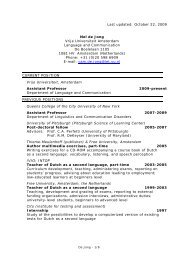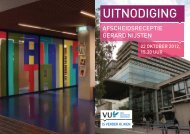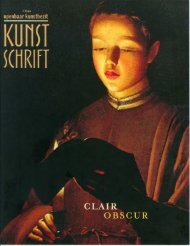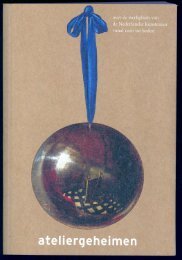Jury report Master and Research Master Thesis Award 2010
Jury report Master and Research Master Thesis Award 2010
Jury report Master and Research Master Thesis Award 2010
Create successful ePaper yourself
Turn your PDF publications into a flip-book with our unique Google optimized e-Paper software.
<strong>Jury</strong> <strong>report</strong> <strong>Master</strong> <strong>and</strong> <strong>Research</strong> <strong>Master</strong> <strong>Thesis</strong> <strong>Award</strong> <strong>2010</strong><br />
Vrije Universiteit - Faculty of Arts<br />
The jury entrusted by the board of the Faculty of Arts to allot the prizes for the best<br />
MA theses of the past year received thirteen submissions. Four of these had served<br />
as the final project of a <strong>Research</strong> <strong>Master</strong> programme, the other nine completed a<br />
normal <strong>Master</strong> programme. As the average length of the theses was around a<br />
hundred pages, the members of the jury spent many hours studying them.<br />
Fortunately this exercise was compensated by the quality of the various theses, both<br />
in terms of the presentation <strong>and</strong> the contents. The majority had been written in what<br />
we experienced as near native English, those in which the Dutch language was used<br />
testified to the linguistic competence which is expected at university level. As to the<br />
contents, the jury could observe that in all cases the c<strong>and</strong>idates had proved their<br />
ability to perform good scholarly research. This was manifested in the formulation<br />
of a significant problem, the gathering of relevant material <strong>and</strong> the h<strong>and</strong>ling of the<br />
observations with well-chosen questions <strong>and</strong> hypotheses.<br />
It is, however, the specific task of the jury to decide to which theses the faculty<br />
prizes should be awarded. In the case of the regular <strong>Master</strong> theses one paper stood<br />
out, but in view of the general quality of the other papers we felt that there was room<br />
for an honourable mention of one of these. For this honour we finally chose the<br />
survey of the role played by women in the process of changes in the Dutch Indies<br />
during the first half of the twentieth century. The paper shows how focussing on<br />
social emancipation rather than on political goals contributed in its own way to the<br />
complicated process of changes. The jury was particularly impressed by the author’s<br />
interpretation of relevant images in women’s magazines as an intrinsic part of the<br />
social developments. For this reason we find that what might be called the ‘second<br />
prize’ should be awarded to Adrienne Huijzer for her thesis ‘Escaping Kartini.<br />
Indonesian women as agents in a changing colonial society, 1900-1942’.<br />
vrije Universiteit amsterdam<br />
© 2011 Vrije Universiteit, Amsterdam
2<br />
The jury held no doubts that the official prize of the faculty for a regular <strong>Master</strong><br />
thesis should be awarded to the author of a paper which also deals with the twentieth<br />
century, in this case its second half in Europe. Many tend to think that in the<br />
Deutsche Demokratische Republik the domain of the visual arts was entirely in the<br />
h<strong>and</strong>s of those who worked in accordance with the official guidelines for socialist<br />
realism. In the thesis to which the jury wants to award the prize an entirely different<br />
picture emerges. Private art galleries <strong>and</strong> individual artistic freedom competed with<br />
government policy in the complicated world of Stasi infiltration on the one h<strong>and</strong> <strong>and</strong><br />
forms of connivance by the authorities on the other. All this is analyzed <strong>and</strong><br />
interpreted on the basis of a real treasury of primary evidence, gathered not only by<br />
documents, but also in conversations with those who had taken part in the<br />
‘unofficial’ art circuits. In her ‘Hunger nach Bildern, Gier nach Leben, Appetit auf<br />
Veränderung’ Faby Bierhoff shows the reader ad oculos how autonomous forms of<br />
art survived in their own way in a dictatorial society. This fine thesis fully deserves<br />
the prize.<br />
<strong>Award</strong>ing the prize to one of the four <strong>Research</strong> <strong>Master</strong> theses was definitely more<br />
difficult. In fact, purely on its own merits each of them deserved the prize. This is,<br />
however, awarded as a result of a comparison between the competitors. In this case<br />
too the jury wanted to allot a ‘second prize’, namely to a paper in which the growing<br />
interest in historical research of the so-called ‘collective memory’ has materialized<br />
in a meritorious manner. The paper deals with the difficult <strong>and</strong> even painful relations<br />
to the Dutch colonial past in the East Indies. Having sketched the scholarly <strong>and</strong><br />
theoretical framework within which he developed his research, the author deals with<br />
four representative cases, in which the problems of shared reminiscences, but<br />
divergent judgments of historical facts are convincingly analyzed <strong>and</strong> interpreted.<br />
Daan de Lange has done a fine job with his paper ‘Een spiegelende oppervlakte’.<br />
The jury finally concluded that the prize for the best <strong>Research</strong> <strong>Master</strong> thesis should<br />
be awarded to a paper which deals with community structures many ages ago in a<br />
period which has not left any written document. The paper is mainly concerned with<br />
vrije Universiteit amsterdam
3<br />
remains of settlements of the seventh <strong>and</strong> sixth millennium B.C. in the region of the<br />
sea of Marmora <strong>and</strong> possible contacts with comparable settlements in Anatolia or<br />
Thrace. Its author first offers a thoughtful <strong>and</strong> extensive exposition of the theoretical<br />
framework within which she performs her specific research. Her first <strong>and</strong> foremost<br />
concern consists in underst<strong>and</strong>ing ‘households <strong>and</strong> inter-household relationships’,<br />
which are not static, but involved in changes. This inspires archaeologists ‘to come<br />
up with social interpretations of the past’, for ‘culture cannot be equated with styles<br />
of pots’. The author then introduces the material results of professional excavations<br />
in the interested regions <strong>and</strong> her own interpretations of these results. What<br />
impressed the jury was her sustained focus on the possibility of hypotheses about the<br />
social role of the household <strong>and</strong> its ‘changing relationships’. This remarkable<br />
synthesis of archaeological fieldwork <strong>and</strong> fruitful hypotheses about social structures<br />
in a thesis in the Faculty of Arts gained the jury’s unanimous decision of the first<br />
prize to Elisha van den Bos for the thesis ‘Beyond dots on a map’.<br />
vrije Universiteit amsterdam


